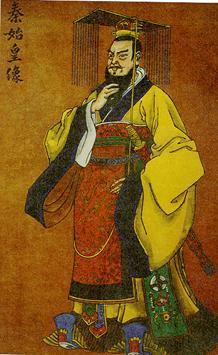Chinese totem
The totem, a symbol of the relatives, ancestors or patron saints of a group, mainly in order to distinguish one group from another, is the earliest phenomenon of cultural history. Due to the underdeveloped nature of early civilization, primitive people believed that certain natural objects or animated creatures with a blood connection to their ethnic heritage could be selected as totems. Thus, using totems to explain or to record myths, ethnic customs and historical affairs became acceptable in primitive times.
In the ancient culture and folklore of China, there are countless materials pertaining to totems. “Kirin, Phoenix, Turtle, Dragon,” which was recorded in “The Book of Rites,” are actually the most famous totems used by our ancestors. ”P(pán)hoenix is the totem of Yin and Dragon is the counterpart of Xia” said by Guo Moruo (A famous writer and palywriter in modern China) in his passage --- “The Research of paintings in Late Zhou (770B.C.-256B.C).” However, as the symbol of one group and the worshiped object of one Nation, totem has a big impact on the culture and the psychology of one Nation. Chinese, the descendents of Xia, choose the powerful Dragon as its totem. So there are many words and idioms and stories related to Dragon, what’s more, emperor was believed as the avatar of Dragon during the ancient times, for instance, Qin Shihuang (The first emperor in the Qin Dynasty) boasted that he was the “Ancestor of Dragon.”
| ?
 Qin Shihuang |
Besides, there are many totems that derived from the origin of clans. There is a legend within Hun which is about wolf, according to ”Wei Guo Records,” the king of Hun had two daughters whom were quite gracious and pretty and even been regarded as the Gods of Hun. One day, the King said: “How can I get such beautiful daughters married with human being? I will let them go with God,” so he constructed a high-profile and let his daughters stand on it. “God, please come and take them away!” he shouted at the heaven. Four years later, an old wolf came here, waiting and howling day and night. The younger girl said to it: “My father got us here and marry us with Gods. It must be the God’s intention to send the wolf here.” Then she got down the profile and married with it. Afterwards, the descendents became more and more and were all good at singing and howling in the way that the wolf did. Consequently, wolf becomes the totem of Hun.
In addition, there are other ethnic groups and clans that use the Chinese Zodiac as totems. Here are some examples:
The Tiger Clan in Bai ethnic group believes that the white tiger is their ancestor. They are tigerish but will not hurt them. They should choose the day of the tiger to go outside and deem that only by doing this can be prayed. Meanwhile, people who want to come back should select the right day, or they will get in trouble. However, the Chicken Clan in Bai?ethnic group?deems that their ancestor was born by the JinHua chicken and they thought that the rooster could foretell the future and pray for them. So when they are migrating, there is always a rooster on the top of their back baskets and they will settle down in the direction of the chicken’s clucking.
The clan of Naxi chooses Oxen as their ancestor. In a book they wrote, it proscribed that Oxen was born in the ocean with its horn penetrating into the sky and its hoof breaking into the ground but was finally killed by the seven brothers and sisters, then they offered its head to Heavens, skin to Earth, muscles to Soil, bones to Stone, ribs to Mountains, blood to River, lungs to Sun, liver to Moon, intestine to Roads, tail to Trees and wool to Flowers and Grass. As a result, the world was born.
There’s also another?ethnic group?that admires Oxen very much---Bouyei. According to the legend, when the ancestors of Bouyei fled away from the arid land, they suddenly found an ox nodding and swaying its tail towards them, so they followed the hint and crossed a mountain with it and was saved by finding the springs. What’s more, Oxen is the symbol of power and strength in the eye of Bouyei. In order to appreciate the Oxen, the ancestor of Bouyei fixed Apr.8th in the lunar month as the “King of the Oxen Festival” and bathed it with Liquidambar Leaves and fed it with rice. Besides, Bouyei designs its badge by combining the Oxen with the “Da Nan Bamboo” together.
Apart from the blood connection with the ethnic heritage, there is another way to select totem, such as reliance. The nomadic tribe and hunters are used to living with horse, nearly all their activities rely on it. In the Daur ethnic group, people call horse ”Wen Gu” and regard it as the God of its tribe, women are forbidden to riding with it, and it can go anywhere and bite anything it like, even the farmland.
As a matter of fact, the word ‘Totem,’ which originated in an Indian language in South America, is a foreign word and was translated according to its pronunciation. Though it’s impossible to find the word in the Chinese ancient books, historical recordings and the admiration to totems are abundant in the books. However, nowadays totem has changed from the ancient badge symbolizing a group’s relatives, spirits and Gods into an advertisement propagating activities or an adornment decorating houses or cars.






















